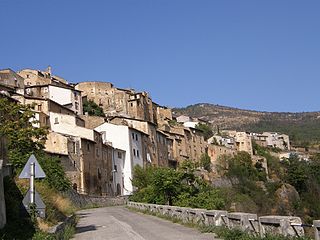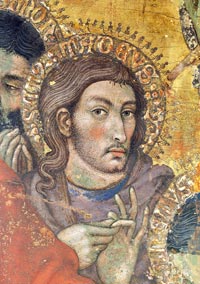
Masaccio, born Tommaso di Ser Giovanni di Simone, was a Florentine artist who is regarded as the first great Italian painter of the Quattrocento period of the Italian Renaissance. According to Vasari, Masaccio was the best painter of his generation because of his skill at imitating nature, recreating lifelike figures and movements as well as a convincing sense of three-dimensionality. He employed nudes and foreshortenings in his figures. This had seldom been done before him.

The Province of L'Aquila is the largest, most mountainous and least densely populated province of the Abruzzo region of Southern Italy. It comprises about half the landmass of Abruzzo and occupies the western part of the region. It has borders with the provinces of Teramo to the north, Pescara and Chieti to the east, Isernia to the south and Frosinone, Rome and Rieti to the west. Its capital is the city of L'Aquila.
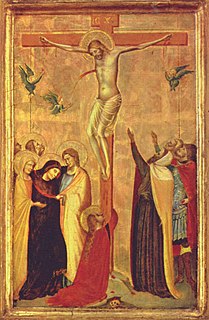
Bernardo Daddi was an early Italian Renaissance painter and the leading painter of Florence of his generation. He was one of the artists who contributed to the revolutionary art of the Renaissance, which broke away from the conventions of the preceding generation of Gothic artists, by creating compositions which aimed to achieve a more realistic representation of reality. He was particularly successful with his small-scale works and contributed to the development of the portable altarpiece, a format that subsequently gained great popularity.

Molina Aterno is a comune and town in the province of L'Aquila in the Abruzzo region of central Italy. The name derives from Latin molina ("mill"), the second part having been added in 1889 due to the presence of the Aterno river.

Lorenzo di Bicci was an Italian painter of the Florentine School considered to be one of the most important painters in Florence during the second half of the 14th century. He is believed to have learned his trade from his father, about whom little is known. Lorenzo’s style, as well as that of his contemporaries Jacopo di Cione and Niccolò di Pietro Gerini, was influenced by the artist Andrea di Cione. Lorenzo's paintings made use of bright colors and his compositions avoided complexity. The figures he painted tended to have round faces and were often expressionless. Another one of Lorenzo's distinctive characteristics was his precision of execution. He was known for exceptional talent in drawing, an ability that he put to use at the initial stages of his painting. Unlike many celebrated Florentine artists of this period, Lorenzo mostly received commissions from the country clergy and from the lower-middle class Florentine guilds. His successors, Bicci di Lorenzo and Neri di Bicci, continued to serve these groups.
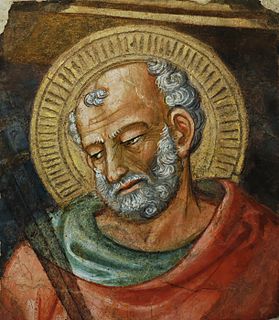
Bicci di Lorenzo (1373–1452) was an Italian painter and sculptor, active in Florence.

Pompeo Cesura, also known as Pompeo Dall'Aquila or Pompeo Aquilano, was an Italian painter and engraver. It is stated in the 'Abecedario Pittorico' by Orlandi to have been a painter of history, specializing both in oil and fresco. He flourished in the latter part of the 16th century. There is a painting by him in the church of Santo Spirito in Sassia in Rome, representing the Deposition, which was engraved by Orazio de Santis in 1572. Several frescoes by him can be viewed in his birthplace of L'Aquila, Abruzzo.

Mariotto di Nardo di Cione was a Florentine painter in the Florentine Gothic style. He worked at the Duomo of Florence, the church of Santa Maria Maggiore, and the Orsanmichele. He created both frescoes and panel paintings, and was also active as a manuscript illuminator.

Tourism in Abruzzo has become one of the most prosperous sectors in the economy of Abruzzo, and in recent years has seen a remarkable growth attracting numerous tourists from Italy and Europe. According to statistics from the Italian institute of statistics (ISTAT), in 2007 arrivals totaled 1,371,155 Italians and 189,651 foreigners. A total of 7,374,646 arrivals were tourists, a figure that puts the region seventeenth among the Italian regions for numbers of tourists per year. According to market analysis and sector studies on tourism in the Abruzzo National Society TurisMonitor 2012, after an increase that was estimated at between 4 and 5% of international tourist arrivals in the Abruzzo region in 2012 was estimated to increase that international arrivals will be around 3/4% by the end of 2012 with staff working in tourism will increase settling at about 25,000 people. Always position first-arrivals from Germany. A moderate support to tourism is also given to the Abruzzo Airport with many low cost and charter flights connecting the entire region with the rest of Europe. Abruzzo tourism can basically be divided into three different types: mountain tourism hiking natural which includes numerous ski resorts, nature reserves and protected areas, beach tourism and coastal with the number of resort, hotel, camping and beaches, and finally the art-historical tourism religious and cultural concentrated mostly in mountain villages and historic towns such as l'Aquila, Vasto, Chieti, Teramo, Sulmona and many others. The region to encourage and promote tourism in 2012 has also opened on different web sites and interactive applications for smartphones and tablets to promote tourism; the regional tourist office is Abruzzo Tourism Promotion, the others are: Twitter "YourAbruzzo, Abruzzo events, Abruzzo Rai Local, SkiAbruzzo and others (Pinterest, Foursquare Studivz, Skyrock, and Hyves destined mainly for the European market, and in particular to the countries of Great Britain, France, Germany, Netherlands, Sweden and Norway.
Andrea de Litio was an Italian painter.

The Master of Pratovecchio was an Italian painter of the Renaissance, named by Roberto Longhi in a 1952 article on the basis of stylistic similarities of a number of works to an altarpiece painted for the monastery of San Giovanni Evangelista in Pratovecchio. The centre panel of the triptych, depicting the Assumption of the Virgin is currently on deposit in Arrezo; the left and right side-panels are in the National Gallery, London.
Giovanni di Francesco del Cervelliera or Giovanni di Francesco was an Italian painter, active in Florence in the mid-fifteenth century.

The Terni–Sulmona railway is a regional railway line in central Italy, managed by Rete Ferroviaria Italiana. It links three regions, Umbria, Lazio and Abruzzo, and three provincial capitals: Terni, Rieti and L'Aquila. Together with the Sulmona–Isernia railway it forms a north–south corridor through the Apennines in central Italy. Its route is the result of two unfinished railways that had to meet in Rieti: the Pescara–L'Aquila–Rome line, and the Terni–Avezzano–Roccasecca line.

Saturnino Gatti (1463–1518) was an Italian painter and sculptor active in an early-Renaissance style.

Francesco da Montereale (1476-1541) was an Italian painter of the early-Renaissance period, active in L'Aquila, region of Abruzzo.
The following is a timeline of the history of the city of L'Aquila in the Abruzzo region of Italy.
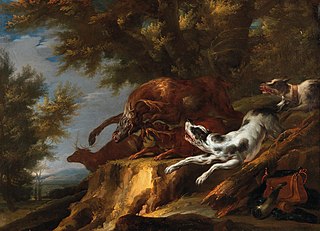
Carl Borromäus Andreas Ruthart, also known as Carl Ruther and Karl Ruthard; in Italian as Carlo Borromeo Rutardo was a German painter who spent most of his career in Italy. During the last years of his life, he was referred to as Frà Andrea. He considered himself to be a follower of Peter Paul Rubens.


